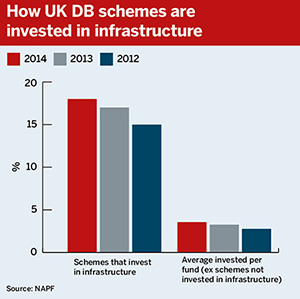The chief of the London Pensions Fund Authority has said the £500m tie-up with the Greater Manchester Pension Fund, announced last week, will consider “infrastructure in a broad definition”.
There has been an increased appetite for infrastructure investing among pension funds over recent years, motivated by the search for better returns in a low-yield environment.
The LPFA and GMPF programme will see the funds invested in UK projects over the next three to four years.
We’ll look at core and non-core assets, debt and equity investment. So we’re not ruling anything out
Susan Martin, LPFA
Susan Martin, chief executive officer of the LPFA, said it was “not ruling anything out” when it came to sourcing suitable projects.
However, Martin said the funds were taking a broader definition of infrastructure and would include property in their investment programme. “We’re open to opportunities,” she said.
“We’ll be looking at infrastructure in a broad definition; we’re including property in that definition, it could be transport, it could be debt, it could be utilities, it could be biomass.”
Martin added both funds were conscious of their liabilities and their commitment to paying pensions for a long period.
“We think there are opportunities in the UK in a range of lifetime infrastructure assets that will allow us to get that return while at the same time helping the UK economy.”
There has been an uptick in appetite for infrastructure in recent years. The National Association of Pension Funds’ annual survey for 2014 showed the percentage of defined benefit schemes investing in the asset class rose to 18 per cent last year, up from 15 per cent in 2012.

The average percentage of scheme assets invested also increased, to 3.5 per cent in 2014 compared with 2.7 per cent in 2012. And data from FT service MandateWire indicate infrastructure mandates increased slightly to 25 last year, from 21 in 2013.
Construction risk
LPFA has already invested in Pontoon Dock in London’s Docklands, while GMPF has invested in a city centre office block in Manchester.
However, Martin added that the search for return could potentially take their investments beyond the UK.
She also pointed to the opportunity presented by high-speed rail project HS2 and the regeneration that would take place along the line, including retail and additional transport links.
But stumbling blocks for pension scheme investors include a perceived lack of investable assets and construction risk, which has limited many schemes to ‘brownfield’ mature assets rather than the less-constrained ‘greenfield’ assets.
“We’ve said that we’ll look at operational greenfield projects,” Martin said. “We’ll look at core and non-core assets, debt and equity investment. So we’re not ruling anything out.”
In December, the LPFA announced a £10bn asset-liability management partnership with Lancashire County Pension Fund, designed to drive down costs through pooling their assets.
Martin said she expected other pension funds would want to collaborate with the LPFA on future infrastructure projects.
She added: “Both of those are about pension funds coming together, to get good opportunities, to get good returns for their members and to manage those deficits.”














